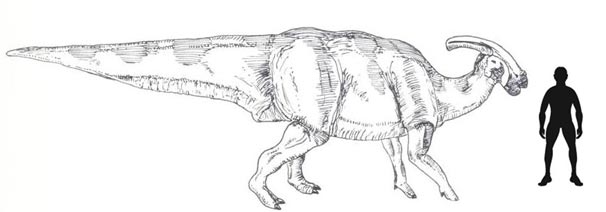The Fascinating Tale of a Hadrosaur’s Tail
Researchers Uncover the Articulated Caudal Vertebrae of a Lambeosaurine Hadrosaur
A team of palaeontologists and researchers from the National Autonomous University of Mexico (UNAM) and the National Institute of Anthropology and History (INAH), also of Mexico, have a tale to tell as they have just finished uncovering the tail bones of an enormous, Late Cretaceous duck-billed dinosaur.
Hadrosaur fossils have been found before in Mexico, but what makes this discovery so fascinating is that the fifty or so caudal vertebrae are articulated – positioned in relation to each other as they would have been when the dinosaur roamed.
Hadrosaur Tail
The fossilised tail has been dated to the Maastrichtian faunal stage* of the Late Cretaceous, the strata in the area is approximately 72 million years old and although the genus and species has not yet been determined, the palaeontologists are certain that their dinosaur was a sizeable beast, after all, the tail itself is more than five metres in length. It is likely that the dinosaur would have measured something in the region of twelve metres in total. The fossil comes from the Coahuila desert region of Ejido Guadalupe Alamitos municipality of General Cepeda.
* Further analysis led to a revision with the fossil material associated with the upper Campanian.
The duck-billed dinosaur fossil was spotted by José López and Rodolfo Espinoza, in early May 2005. However, it was only reported to the National Institute of Anthropology and History last month and after a quick, preliminary inspection a field team was despatched to excavate the specimen. Digging started on July 2nd and the field team thought that they were dealing with just a few vertebrae, but after twenty days, the almost complete tail had been revealed.
Other elements from the skeleton have also been found including bones from the hip area, these in conjunction with the caudal vertebrae, have led scientists to suggest that this is a fossil of a lambeosaurine hadrosaur. It is likely that this dinosaur sported a crest on its head, perhaps it was similar to a Parasaurolophus.
Picture credit: Everything Dinosaur
First Fully Articulated Dinosaur Tail Discovered in Mexico
This is the first fully articulated dinosaur tail found in Mexico and is one of the few complete articulated dinosaur tails that have ever been found in the world. The researchers are optimistic that they will find the rest of the dinosaur in the rock beneath the site where the tail was found.
Back in 2008, team members at Everything Dinosaur reported on the discovery of Mexico’s first unique dinosaur, another Lambeosaurine Hadrosaur that was named Velafrons coahuilensis. This specimen was the first example of a significant dinosaur fossil in Mexico that did not reflect other specimens found in the southern United States.
To read about this discovery: Viva Mexico! Lambeosaurine Dinosaur Discovery.
More recently, the discovery of a horned dinosaur was announced. To read an article about a ceratopsian from Mexico: Giant Horned Dinosaur from Mexico.
A Special Find
A spokesperson from Everything Dinosaur commented:
“This is a really special fossil find. With the tail bones in such an alignment palaeontologists can understand more about how the tail actually functioned, the specimen is so well-preserved that the space where cartilage was distributed between the actual bones can be identified. This will help scientists to understand more about the biomechanical properties of the tail.”
Commenting on the field work, palaeontologist Angel Ramirez Velasco, one of the team members on the project stated:
“This finding is important for the biological study of dinosaurs, we will have a sequence that will reveal the characteristics of the vertebrae. They will be seen differentiating in size depending on their position in the spine.”
The hefty specimen will be removed from the field location in sections, to avoid as much damage as possible. The pieces will then be put back together again in a special laboratory. After further cleaning and study, it is hoped that this amazing fossil will be put on general display so that members of the public can marvel at the tail-end of a Late Cretaceous herbivore, that once roamed Mexico.
For models and replicas of Late Cretaceous lambeosaurines and other dinosaurs: PNSO Age of Dinosaurs Models and Figures.


